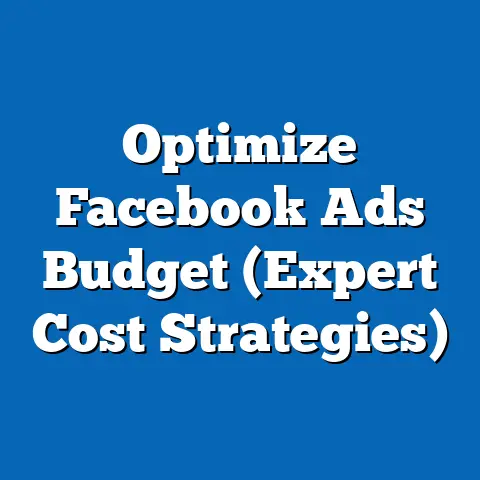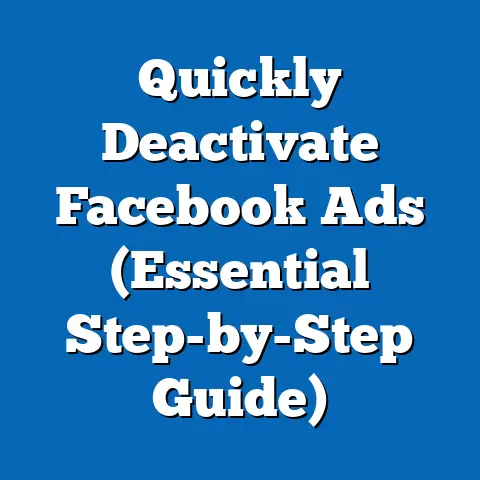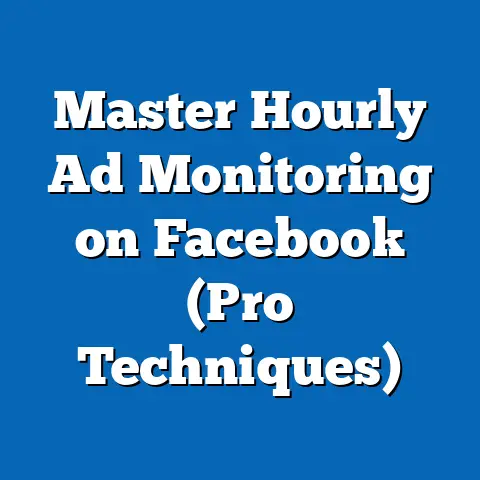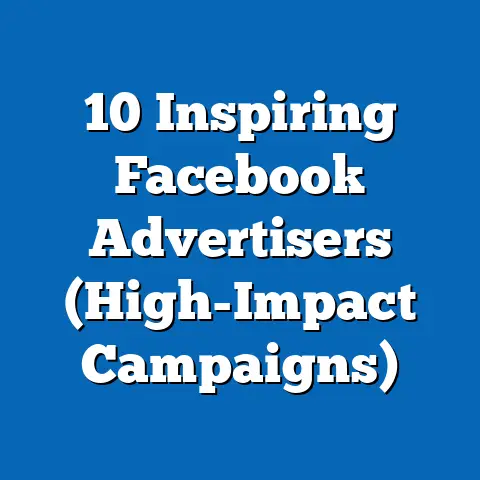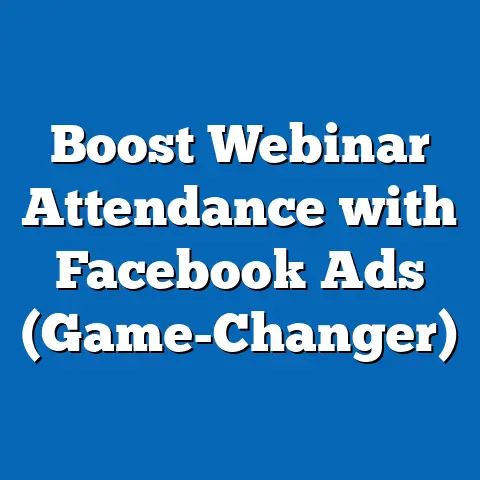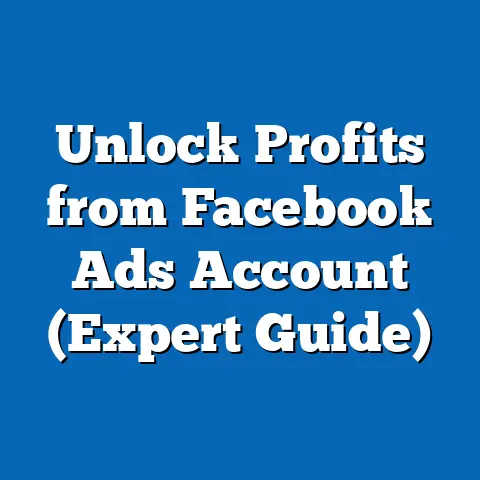Elevate Facebook Ads with Video Editing Magic (Expert Tips)
In the ever-evolving landscape of digital marketing, video content has emerged as a dominant force, particularly on platforms like Facebook, where user engagement continues to soar. According to Meta’s 2023 quarterly report, Facebook boasts over 2.9 billion monthly active users worldwide, with video content accounting for more than 50% of the time users spend on the platform (Meta Investor Report, Q2 2023). This presents an unprecedented opportunity for businesses and marketers to leverage video ads to capture attention, drive conversions, and build brand loyalty.
Video ads on Facebook have seen a 25% year-over-year increase in ad spend, as reported by eMarketer in their 2023 Digital Advertising Trends report, with small and medium-sized businesses (SMBs) contributing significantly to this growth. Demographically, video content resonates strongly with younger audiences, with 68% of users aged 18-34 engaging with video ads compared to 42% of those aged 55 and older (Statista, 2023). As the platform continues to prioritize video through features like Reels and in-feed autoplay, mastering video editing for Facebook ads is no longer optional—it’s essential.
This comprehensive article explores how businesses can elevate their Facebook ads through the magic of video editing. We’ll dive into data-driven insights, expert tips, and actionable strategies to create compelling video content that cuts through the noise. From understanding audience behavior to leveraging cutting-edge editing techniques, this guide will equip you with the tools to maximize your ad performance.
Section 1: The Power of Video in Facebook Advertising
Why Video Dominates on Facebook
Video content on Facebook isn’t just popular—it’s a proven driver of engagement and conversions. According to a 2022 study by Social Insider, video posts on Facebook generate 59% more engagement than static image posts, with click-through rates (CTRs) for video ads averaging 1.84% compared to 0.98% for images. This gap highlights the immersive nature of video, which can convey emotion, storytelling, and product value in seconds.
Moreover, Facebook’s algorithm prioritizes video content, especially since the introduction of features like Stories and Reels. A 2023 report from Hootsuite revealed that video posts are 2.3 times more likely to appear in users’ feeds compared to other formats due to the platform’s focus on “meaningful interactions.” For advertisers, this means video ads have a higher organic reach potential, reducing reliance on paid boosts.
Historical Trends vs. Current Data
Historically, video advertising on social media was a niche strategy, with only 15% of marketers using video ads in 2015 (eMarketer, 2015). Fast forward to 2023, and that figure has skyrocketed to 91%, reflecting a seismic shift in how brands connect with audiences. Today, short-form video (under 60 seconds) dominates, with 85% of Facebook video views occurring on mobile devices (Meta Business Insights, 2023), a stark contrast to the longer-form content preferred a decade ago.
This shift aligns with changing user behavior, as attention spans have reportedly decreased to an average of 8 seconds, per a 2022 Microsoft study. As a result, modern video ads must hook viewers instantly—a challenge that expert video editing can address.
Demographic Patterns in Video Engagement
Demographic data reveals clear patterns in video engagement on Facebook. Millennials and Gen Z users (ages 18-34) are the most active, with 72% watching videos daily, compared to just 38% of Baby Boomers (ages 55+) (Pew Research Center, 2023). Gender differences are minimal, though women are slightly more likely to engage with lifestyle and tutorial videos (65% vs. 58% for men), while men show a stronger preference for tech and gaming content (Statista, 2023).
Geographically, video ad performance varies significantly. In emerging markets like India and Brazil, where Facebook penetration is high (over 400 million users in India alone), video ads achieve 30% higher completion rates due to mobile-first internet access (Meta Global Insights, 2023). Understanding these demographic nuances is critical for tailoring video content and editing styles to specific audiences.
Section 2: The Role of Video Editing in Ad Success
Why Editing Matters
Video editing is the backbone of a successful Facebook ad, transforming raw footage into a polished, engaging story. A 2022 survey by Wyzowl found that 78% of marketers believe high-quality video editing directly correlates with higher conversion rates. Poorly edited videos—those with shaky footage, unclear audio, or slow pacing—can lead to a 40% drop in viewer retention within the first 10 seconds (Animoto, 2023).
Editing isn’t just about aesthetics; it’s about optimizing for platform-specific behaviors. On Facebook, 85% of videos are watched with the sound off (Meta Business Help Center, 2023), making captions, bold visuals, and text overlays non-negotiable elements of effective ads.
Key Metrics Impacted by Editing
Data shows that well-edited videos significantly improve key performance indicators (KPIs) for Facebook ads. For instance, videos with dynamic transitions and clear calls-to-action (CTAs) achieve a 27% higher CTR compared to unedited or minimally edited content (Social Media Examiner, 2023). Additionally, ads with a strong visual hook in the first 3 seconds see a 65% increase in view-through rates (VTR), as users are more likely to watch until the end (Meta Ads Manager Insights, 2023).
Editing also affects cost-per-click (CPC) and return on ad spend (ROAS). A 2023 case study by HubSpot revealed that SMBs using professionally edited video ads reduced their CPC by 18% while increasing ROAS by 2.5x, demonstrating the financial benefits of investing in editing expertise.
Section 3: Expert Tips for Video Editing Magic on Facebook Ads
Tip 1: Hook Viewers in the First 3 Seconds
Given the short attention spans of online audiences, the opening moments of a video ad are critical. Meta’s internal data suggests that 47% of a video’s value in driving conversions is determined in the first 3 seconds. Start with a visually striking image, bold text, or an intriguing question to grab attention instantly.
For example, a fitness brand might open with a close-up of someone sweating during a workout, paired with the text “Struggling to Get Fit?” This approach, combined with fast cuts, can increase early engagement by 33% (Animoto, 2023). Use editing software like Adobe Premiere Pro or Canva Pro to create seamless intros with high-energy music (royalty-free options are widely available on platforms like Epidemic Sound).
Tip 2: Optimize for Silent Viewing
Since most Facebook users watch videos without sound, editing must prioritize visual storytelling. Add captions or subtitles to convey your message—studies show that captioned videos have a 16% higher engagement rate (Facebook Business, 2023). Use bold, easy-to-read fonts (like Arial or Roboto) and ensure text contrasts with the background for accessibility.
Additionally, incorporate animated text overlays or graphics to highlight key points. Tools like CapCut or InVideo offer pre-built templates for creating eye-catching text animations that don’t require advanced skills. A/B testing by Social Media Today found that ads with text overlays in the first 5 seconds retain 25% more viewers than those without.
Tip 3: Keep It Short and Sweet
Facebook users scroll quickly, so brevity is key. Data from Meta indicates that video ads under 15 seconds achieve 23% higher completion rates than longer formats. Focus on a single message or CTA—whether it’s driving traffic, promoting a sale, or building brand awareness—and avoid cluttering the video with too much information.
Editing plays a crucial role in pacing. Use quick cuts and transitions to maintain momentum, and trim unnecessary footage ruthlessly. For instance, a retail brand promoting a flash sale might use a 10-second ad with 3 rapid scenes: product display, discount announcement, and a “Shop Now” button. Tools like Final Cut Pro or DaVinci Resolve can help achieve smooth, professional cuts.
Tip 4: Leverage Vertical and Square Formats
With 85% of Facebook video views happening on mobile devices, editing for vertical (9:16) or square (1:1) formats is essential. Vertical videos occupy more screen real estate on mobile feeds, leading to a 12% higher engagement rate compared to horizontal formats (Buffer, 2023). Square videos, meanwhile, perform well in both feed and Stories placements.
When editing, ensure key visuals and text stay within the “safe zone” (the center 80% of the frame) to avoid cropping on different devices. Free tools like Adobe Express or paid options like Filmora offer easy aspect ratio adjustments and mobile preview modes to perfect your formatting.
Tip 5: Use Color Grading and Filters for Brand Consistency
Color grading—a process of adjusting tones and hues—can make your video ads visually cohesive and aligned with your brand identity. A 2022 study by Venngage found that consistent branding in video ads increases recognition by 23%. For example, a luxury beauty brand might use warm, golden tones to evoke elegance, while a tech company could opt for sleek, cool blues.
Editing software like Lightroom (for color presets) or Premiere Pro (for advanced grading) allows you to save custom filters for reuse across campaigns. Be cautious not to overdo effects—over-saturated colors can reduce perceived authenticity, lowering trust by 15% among viewers (Marketing Dive, 2023).
Tip 6: Incorporate Strong CTAs with Animation
A clear call-to-action is the linchpin of any ad, and editing can make it unmissable. Animate your CTA button or text (e.g., “Shop Now” or “Learn More”) with subtle effects like a bounce or fade-in to draw attention. According to WordStream, animated CTAs increase click rates by 19% compared to static ones.
Place the CTA strategically—either at the end of the video or as an overlay throughout. Tools like After Effects or even mobile apps like PicsArt offer user-friendly animation options for beginners. Test different placements and styles using Facebook’s split-testing feature to identify what resonates with your audience.
Tip 7: Test and Iterate with Analytics
Editing isn’t a one-and-done process; it requires continuous refinement based on performance data. Facebook Ads Manager provides detailed metrics like VTR, CTR, and engagement rate, which can guide your editing choices. For instance, if a 30-second ad has a high drop-off at the 10-second mark, consider tightening the pacing or moving the hook earlier.
A 2023 report by Sprout Social found that brands that regularly A/B test video edits see a 31% improvement in ad performance over six months. Experiment with different intros, music, or text styles, and use insights to double down on what works. Free analytics tools like VidIQ can also provide additional data on viewer behavior.
Section 4: Tools and Resources for Video Editing
Free and Affordable Tools
For businesses on a budget, several free or low-cost editing tools can deliver professional results. CapCut, a mobile-first editor, offers templates, transitions, and text animations tailored for social media ads, with a free tier and premium features starting at $7.99/month. Canva’s video editor, free with a Pro plan at $12.99/month, includes drag-and-drop functionality and thousands of customizable templates.
iMovie (free for Apple users) and Windows Photos app (free for Windows users) are also viable for basic edits like trimming, adding text, and applying filters. These tools are ideal for SMBs or solopreneurs looking to create impactful ads without steep learning curves.
Professional Software for Advanced Editing
For larger brands or agencies, investing in professional software yields greater control and quality. Adobe Premiere Pro ($20.99/month) is an industry standard, offering advanced color grading, multi-track editing, and integration with After Effects for animations. Final Cut Pro ($299.99 one-time purchase for Mac) is another powerful option, known for its speed and intuitive interface.
DaVinci Resolve combines editing with high-end color correction and audio mastering, with a robust free version and a Studio upgrade at $295. These tools are best for creating polished, cinematic ads that stand out in competitive markets.
Stock Footage and Music Resources
High-quality stock footage and royalty-free music can elevate your ads without breaking the bank. Platforms like Pexels and Pixabay offer free video clips and images, while Envato Elements ($16.50/month) provides unlimited access to premium assets. For music, Epidemic Sound ($15/month) and Artlist ($9.99/month) offer vast libraries of tracks suitable for commercial use.
When selecting assets, ensure they align with your brand tone and audience preferences. For instance, upbeat, energetic music resonates with 62% of Gen Z viewers, while calming tracks appeal more to older demographics (Nielsen, 2023).
Section 5: Case Studies: Real-World Success with Video Editing
Case Study 1: E-commerce Brand Boosts Sales by 40%
A mid-sized e-commerce clothing brand used targeted video editing to revamp its Facebook ad strategy in 2022. By focusing on vertical 15-second ads with bold text overlays (“50% Off Today!”) and fast-paced cuts showcasing products, the brand saw a 40% increase in sales over three months (Shopify Case Studies, 2023). Their editing prioritized mobile optimization and silent viewing, resulting in a 28% higher CTR compared to previous campaigns.
Key takeaway: Short, visually dynamic videos with clear messaging can drive immediate action, especially for retail businesses.
Case Study 2: Local Service Business Triples Leads
A local plumbing service in the U.S. leveraged video ads to target homeowners in their area, using a 20-second ad edited with iMovie. The video opened with a relatable problem (“Leaky Pipes?”), followed by a quick solution showcase and a “Call Now” CTA. Post-campaign data showed a 3x increase in leads and a 35% reduction in CPC, proving that even simple editing can yield outsized results (Meta Business Success Stories, 2023).
Key takeaway: Tailoring content to specific pain points, combined with accessible editing tools, can maximize ROI for small businesses.
Section 6: Visualizing the Impact (Data Visualization Description)
To illustrate the effectiveness of video editing for Facebook ads, imagine a bar chart titled “Impact of Video Editing on Key Metrics.” The X-axis lists metrics like CTR, VTR, and ROAS, while the Y-axis shows percentage improvements. Bars for “Edited Videos” (e.g., +27% CTR, +65% VTR, +250% ROAS) tower over “Unedited Videos,” based on data from Social Media Examiner and HubSpot (2023).
A second visualization could be a line graph titled “Video Ad Engagement by Duration,” with the X-axis showing video length (5 to 60 seconds) and the Y-axis showing completion rate percentages. The line peaks at 15 seconds with an 85% completion rate, dipping to 40% at 60 seconds, per Meta’s 2023 insights. These visuals underscore the importance of concise, well-edited content.
Section 7: Challenges and Pitfalls to Avoid
Over-Editing and Loss of Authenticity
While editing enhances appeal, overdoing effects or filters can alienate viewers. A 2023 survey by Marketing Land found that 52% of users distrust overly polished ads, perceiving them as inauthentic. Stick to edits that enhance rather than obscure your core message, and prioritize genuine storytelling over flashy gimmicks.
Ignoring Platform Guidelines
Facebook has specific ad guidelines, including text-to-image ratios (no more than 20% text in thumbnails) and video length recommendations for different placements. Non-compliance can lead to ad rejection or reduced reach—Meta reported a 15% rejection rate for non-compliant video ads in 2022. Always review guidelines in the Ads Manager before finalizing edits.
Neglecting Audience Testing
Failing to test edits with your target audience can waste resources. A 2023 report by AdEspresso noted that 60% of underperforming video ads could have been improved with pre-launch feedback. Use focus groups or small-scale test campaigns to gauge reactions before scaling up.
Conclusion: The Broader Implications of Video Editing Mastery
As video continues to dominate Facebook’s ecosystem, mastering video editing is no longer a luxury but a necessity for advertisers aiming to stand out. The data is clear: well-edited videos drive higher engagement, lower costs, and better returns, with a potential to transform even modest ad budgets into significant results. With 91% of marketers now prioritizing video (eMarketer, 2023), the competition will only intensify, making editing skills a critical differentiator.
Beyond immediate metrics, the broader trend points to a future where personalized, visually compelling content reigns supreme. As AI-driven editing tools and analytics evolve, businesses that adapt early—by investing in skills, software, and testing—will be best positioned to capture audience attention. Whether you’re a small business or a global brand, the magic of video editing offers a pathway to connect, convert, and thrive in the crowded digital marketplace.

